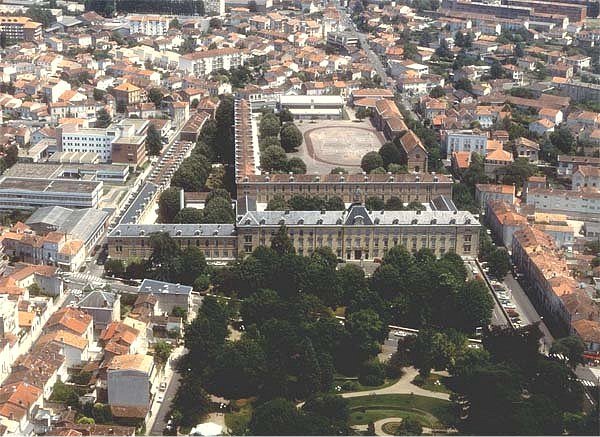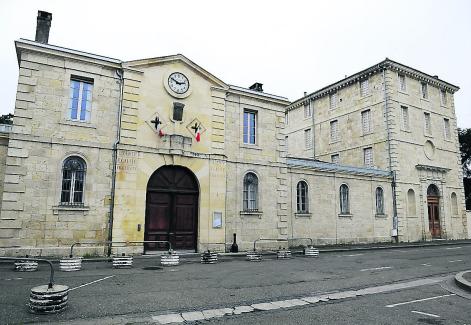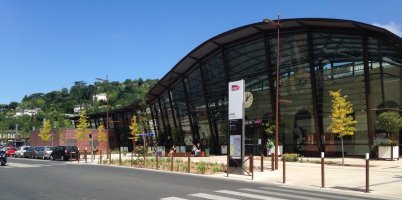 The
country that surrounds it, on both banks of the
Garonne, is the Agenais. Twenty-year-old city
established at the foot of the hillside of the
Hermitage which was the seat of the Gallic oppidum
of Nitiobroges, its history is intimately linked to
that of "Garonne", as the Agenais name their river
by personifying it. If it was nurturing and allowed
the development of trade, its many formidable
floods have given the city the reputation of being
the most flooded in France.
The
country that surrounds it, on both banks of the
Garonne, is the Agenais. Twenty-year-old city
established at the foot of the hillside of the
Hermitage which was the seat of the Gallic oppidum
of Nitiobroges, its history is intimately linked to
that of "Garonne", as the Agenais name their river
by personifying it. If it was nurturing and allowed
the development of trade, its many formidable
floods have given the city the reputation of being
the most flooded in France.
Today
protected by dikes, the city and its agglomeration
have largely spread in the valley. Agen has
preserved from its medieval past an important civil
and religious architectural heritage, enriched in
the late nineteenth century by the construction of
Haussmann-style buildings and houses Art Nouveau
and Art Deco during the piercing of broad
boulevards. The name of Agen is commonly associated
with the prune, whose production area is mainly
located in Lot-et-Garonne and which was formerly
shipped from the port of the city on the Garonne,
as well as in his club's rugby union. emblematic,
the SU Agen, which holds in particular 8 titles of
champion of France.
Economy

Agen's business is today essentially tertiary,
administrative and commercial. The city trip to
play, the main role of the average Garonne, ideally
located between the metropolises of Bordeaux and
Toulouse, developing and promoting trade (O'Green
Shopping Park, renovation of the heart of the
city), family tourism (Walibi South-West,
navigation on the side canal to the Garonne), or
the construction of a congress center and areas of
industrial and commercial activity (Agropole,
Technopole Agen Garonne).
History,
origins

The site of Agen was probably populated at least
since the Neolithic, but it is difficult at the
beginning of the hour. The remains that we
currently have at our disposal testify to a
settlement of Iberian origin to viiie and vii
centuries BC. However, the site occupied at that
time was different from the one we know today: it
is the plateau of the Hermitage. It is also this
situation (on a rocky outcrop) that would have been
the key to the toponymy of the city
The site, although located at the confluence of the
valley of the Mass and the Garonne, is not one of
the most strategic places of the valley. It is
therefore difficult to explain by geography alone
why the Nitiobroges (Celtic people who arrived
around 400 BC) chose this place as the capital of
their kingdom. They had built on this site a
stronghold of about 50 hectares, located 100 meters
above the bed of the Garonne. We found traces of
this occupation of the soil in the nineteenth
century and more recently, thanks to the work of
the team of archaeologists of the Agenais.
The displacement of the city towards the terraces
of the Garonne is undoubtedly anterior to the Roman
occupation. This transfer must be related to the
wealth of trade that took place along the river and
to the Pyrenees and the Massif Central. The
discovery of the very rich grave at Boé Char
is evidence of the opulence of local elites at the
end of the 1st century before Jesus Christ
Aginum,
Gallo-Roman city

The Gallo-Roman city has left important and quite
numerous traces. But most of them have been
destroyed and in particular the most interesting
ones. First of all, the theater, something quite
rare for a city of medium importance, especially
since Aginnum also had an amphitheater (dated 215
AD) that can accommodate 10,000 to 15,000 people.
considerable. There are also clues about the
existence of at least one necropolis. The city
stretched over 80 hectares and was therefore quite
rich and mostly populated. But prosperity was more
related to a transit activity than to a true
commercial pole. This intense passage is to be put
in relation with the early implantation of the
Christian religion. From the end of the third
century, the chronicles relate the martyrs of Saint
Caprais and Saint Foy, who would be buried on the
site of the present church of Martrou. In the
following century, the Christian Church organized
itself with its first known bishop, Phébade,
whose theological work earned him a prestige in all
of Christendom.
Agen
in the
"Moyen-Age"
Hover
over the images to enlarge them ...

As
with many cities, we have few records of the Great
Invasion era. For four centuries, Agen saw the
Vandals, the Visigoths and the Franks pass before
suffering the onslaught of the Vikings in the ninth
century. Historians have noted three invasions: in
843, 853 and the last in 922. The most destructive
invasion is that of 853. It is after this attack
that the relics of Saint Foy were taken to Conques,
probably between 877 and 884.
During the early Middle Ages, Agen remained in
Aquitaine near the Novempopulanie and the Duchy of
Vasconie. After the year 660, Vasconie and
Aquitaine became independent of the Franks and
reached their peak with Eudes d'Aquitaine. In 732,
the Saracens invaded the Vasconie and Bordeaux, but
their progress was stopped by Charles Martel and
Eudes between Poitiers and Tours. Pepin the Short
pursues the conquest of all Aquitaine and, in 766,
the Vascons, ancestors of the Basques (called
Wascones) went to Pepin Agen. The city fell back on
itself and fortified itself in its first enclosure
(about ten hectares) around the cathedral
Saint-Étienne (location of the current
market-covered parking) and whose foundation is
difficult to date. Having never been completely
finished, the building deteriorated and threatening
to collapse it was demolished in the early
nineteenth century.
It is around this nucleus that the medieval city
developed whose urban plot was organized from the
rue des Cornières (of which it remains a
part) which ended up Place du Marché (today
Place des Dairy). that is to say at the foot of the
old cathedral. The main vestiges of the medieval
Agen are religious buildings. We have already seen
that the Saint-Etienne cathedral has disappeared.
But the most magnificent monument is undoubtedly
the church of the Jacobins (today transformed into
a cultural center). The church is the last vestige
of the convent of the Jacobins (or Dominicans) and
dates from the thirteenth century. The
construction, with the exception of the three
central pillars (stone) separating the vessel into
two naves, is made of brick. Recent restoration
work has revealed murals depicting Alphonse de
Poitiers (lord of the city and protector of the
convent at its construction). It was the site of
great local or regional events: in 1354, the Black
Prince received the tribute of 40 barons and in
particular that of Gaston Phoebus.

The
city had a large number of other religious
buildings, convents or churches such as the current
cathedral: the collegiate Saint-Caprais, largely
Romanesque. Around the church was an architectural
ensemble to accommodate the canons: monastery,
cloister ... of which there remains only the
chapter house. Exploiting the feudal rivalries
between Plantagenet (succeeding the Counts of
Poitiers) and Counts of Toulouse and between Kings
of England and Capetian, bishops and inhabitants
could escape the tutelage of their lords.

From
the twelfth century, the city enjoys a certain
autonomy, it has a custom, freedoms and franchises.
This autonomy is confirmed in the thirteenth
century (the charter dates from 1248) and the
tutelage of the king (or the count) and the bishop
is more and more cowardly. The city is administered
by consuls who affix on the solemn acts the great
seal of the city representing on the obverse a
fortified city with inside a bell tower and on the
reverse an eagle. But the consular administration
is not democratic, it is an oligarchy that often
abused its powers, resulting in several popular
revolts in the following centuries.
 The
city was indeed significantly enlarged during the
Middle Ages: it now reaches 60 hectares. Agen was a
prosperous and populated city (perhaps 10,000
inhabitants whereas Toulouse had less than 40,000)
living in particular activities related to the
Garonne: trade, fishing, milling. However, although
the city did not suffer too much directly from the
terrible clashes of the Hundred Years War (it even
gained a little more autonomy) it suffered the
consequences of the ravages of the surrounding
countries. In addition, the fourteenth and
fifteenth centuries experienced the terrible
epidemic of black plague aggravated by many and
devastating bad weather. The Garonne in particular
struck by deadly floods.
The
city was indeed significantly enlarged during the
Middle Ages: it now reaches 60 hectares. Agen was a
prosperous and populated city (perhaps 10,000
inhabitants whereas Toulouse had less than 40,000)
living in particular activities related to the
Garonne: trade, fishing, milling. However, although
the city did not suffer too much directly from the
terrible clashes of the Hundred Years War (it even
gained a little more autonomy) it suffered the
consequences of the ravages of the surrounding
countries. In addition, the fourteenth and
fifteenth centuries experienced the terrible
epidemic of black plague aggravated by many and
devastating bad weather. The Garonne in particular
struck by deadly floods.
The
time of the "Renaissance"

From the end of the Hundred Years War to the first
troubles of the wars of Religion, Agen experienced
a renaissance both material and intellectual. A
wave of immigration from the Massif Central, West
and Pyrenees repopulated the region. In addition,
the diocese was led by five successive Italian
bishops, many of them from the La Rovere family,
related to Pope Julius II. They were fine scholars,
like Mateo Bandello, author of short stories. This
is one of them, probably written at Bazens,
residence of the bishops of Agen, which inspired to
Shakespeare Romeo and Juliet. They came with a
whole suite of obscure people but also very
brilliant as the doctor and humanist Julius Caesar
Scaliger, known throughout Europe, or his son,
Joseph-Juste, acquired the Reformation (this is one
"illustrious" Agenais). Agen, a Catholic city (and
rival of Nérac, political and intellectual
capital of the Reformed), was repeatedly occupied
and looted by Protestant troops during this
dramatic period. It will shelter for some time the
Queen Marguerite de Valois, known as Queen
Margot.
The peace returned, the city knew a revival of
prosperity after a difficult Great Century, like
the rest of the country, because of climatic
conditions prejudicial to agriculture, activity of
which the city was very dependent. Popular
seditions, pestilences and famines mean that the
real return to prosperity did not take place until
the eighteenth century, which the numerous civil
buildings attest to: mansions of wealthy noble or
bourgeois families enriched in commercial and
textile activity. Only at the end of the century
was built the magnificent episcopal palace, which
later became the headquarters of the prefecture. At
that time, Agen was a manufacturing town
specialized in sailcloth but also sheets, ropes and
various fabrics. The city is leaving more and more
of its ramparts. She no longer fears the political
troubles but only the moods of the Garonne.
However, we do not hesitate to embellish the banks
of the river by developing the walk called "Gravel"
planted with abalone (now amputated and disfigured
by the path on the bank and the wall that now
separates the city from its river). This place was
home to major fairs, especially that of June where
barges came from all over Europe. The city is in
fact dependent more and more on its river which
exports to the Americas the flour of the High
Country that is exchanged there for sugar. Dried
plums are also sold to sailors who, during the
voyage, avoid scurvy. The wine trade was also very
important but hampered by the privilege of Bordeaux
wines prohibiting the sale of wines upstream until
Christmas, part of the production was transformed
into brandy.
Agen
in the XIXth

The Revolution then the continental blockade and
the beginnings of the industrial revolution will
bring heavy blows to the activities of Agen. But
this economic numbness that we see in the
nineteenth century is also to be put to the account
of the local bourgeoisie, which has lost its
dynamism and retreats to a less lucrative land
rent: the agricultural show of Agen 1855 seeks yet
to demonstrate the superiority of the fake on the
steering wheel! As Peter Weissberg wrote in the
history of Agen published by Privat in 1991: "Agen
has not missed its industrial revolution: it has
not even attempted." Thus, the assets that
constituted the railroad and the side channel of
the Garonne, which was, after transformation into
"canal of the two seas", according to the military
"to take half of the traffic of Gibraltar and to
avoid our fleet the humiliation to pass under the
English canons ", were insufficiently used or did
not see the light of day. The influx of people from
the Massif Central, the Pyrenees and Spain
compensated for the very large labor deficit in a
region in serious demographic decline but mainly
absorbed by construction and agriculture. The
nineteenth century, however, was one of great
achievements of the community. Since 1827, Agen
finally has a bridge (several attempts have
aborted, from the Middle Ages to the sixteenth
century and for 300 years we crossed the Garonne by
ferry), doubled by the bridge suspended in 1839 and
finally the canal bridge, completed in 1843 , a
masterpiece with 23 arches spanning the river and
its bed. It was in 1875 that the Garonne
experienced its most dramatic flood (it made 500
deaths in Toulouse and 8 in Agen) but the canal
bridge had resisted.

|

|
Hover
over the images to enlarge them ...

The
true transformations of the urban fabric of Agen
took place only under the mandate of Jean-Baptiste
Durand, between 1880 and 1895 (the city counted at
that time 20 000 inhabitants). The two main
boulevards were pierced today: République
and Carnot, the latter leading to the newly built
station (the main building was completed in 1858
and two side wings were added in 1886 and destroyed
in 1981). On the route of the old ramparts,
dismantled at the Revolution, belt boulevards were
made. These large sites, however, destroyed
testimonies of the past like most of the Sainte-Foy
church. In 1888 is inaugurated the new high school
Bernard-Palissy d'Agen, built on a mound so that it
is safe from floods. The second high school of the
city (technical high school
Jean-Baptiste-de-Baudre, the name of the engineer
designer of the lateral canal) occupies the walls
of the major seminary, imposing building of the
late seventeenth century, built by Bishop Mascaron
to complete the work of the Counter-Reformation.

|

|
Hover
over the images to enlarge them ...

It
is finally Jean-Baptiste Durand who has built on
the site of the old cathedral the covered market,
in the style of the halls of Baltard, unfortunately
also disappeared. Fortunately, away from these
great works still remain small arteries, streets
and alleys with half-timbered houses and corbels or
old hotels of stone or brick. These buildings, the
oldest of which date back to the 14th century, give
Agen a particular cachet that can be found in other
cities of medium importance, sheltered from an
overly bulimic expansion.